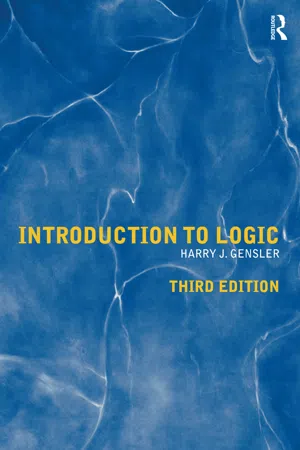Languages & Linguistics
Straw Man Argument
A straw man argument is a rhetorical technique where someone distorts or misrepresents their opponent's position in order to make it easier to attack. This tactic involves creating a weaker version of the opposing argument and then attacking that version instead of engaging with the actual argument. It is often used to discredit an opposing viewpoint without addressing its core points.
Written by Perlego with AI-assistance
Related key terms
Related key terms
1 of 4
Related key terms
1 of 3
3 Key excerpts on "Straw Man Argument"
- eBook - ePub
You've Got To Be Kidding!
How Jokes Can Help You Think
- John Capps, Donald Capps(Authors)
- 2011(Publication Date)
- Wiley-Blackwell(Publisher)
does want the offender to suffer for the harm that was done. In some cases, a third party steps in and sets the terms on how the offender will be made to suffer. Consider the case of Roy E. Frankhouser, who called himself a chaplain to the Ku Klux Klan. He harassed a woman by taking photographs of his victim through her office window, broadcasting images of an explosion destroying her office, making threatening phone calls, and distributing threatening fliers. The victim, a social worker whose job was to assist people filing discrimination complaints, was so fearful that she left her job and her home and repeatedly moved from one residence to another. The court imposed punishment for the wrongs he committed against her included submitting written copies of an apology to a major newspaper, performing community service, making efforts to promote anti-discrimination campaigns, and contributing a percentage of his salary to the victim and her daughter (Lazare 2004, p. 62).Some people think that it’s enough for the wrongdoer to make a sincere apology, but this is not necessarily the case: the victim’s need for restoration of self-respect may be met by exercising the power (legal) to make the offender suffer. Another need that is satisfied is the need to believe that important values are in fact shared and that the offender feels bound by the social contract (Lazare 2004, p. 63). What’s important to keep in mind is that there’s a difference between requiring the offender to suffer and committing a retaliatory offense against the offender as a way of “getting even.”The Straw ManA fourth fallacy of assumption is the straw man fallacy. If, in responding to someone else’s argument, you deliberately distort it so as to weaken it, you commit the straw man fallacy. In the form in which you represent the other person’s argument, it is easy to refute. That’s why it’s called a straw man. A straw man, after all, is an easy pushover. There’s a difference, though, between committing this fallacy and making an honest mistake in interpreting what the other person has argued. Some arguments are complex and are not easy to grasp and sometimes our effort to restate the other person’s argument requires modification or correction. But the commission of the Straw Man Argument is a dishonest mistake because it involves the deliberate distortion of the other person’s argument (McInerny 2005, p. 112). In effect, you want to make the other person look ridiculous and want those who are listening to the argument to say about your opponent’s argument, “How could anyone possibly believe that?” So the straw man is an exercise in bad faith, as it often has an ad hominem intent.This fallacy is often used in politics because the one who uses it not only wants to make the other person’s argument look bad but also wants the other person to look bad. Other people may not necessarily care about the issues that are being argued about but they do care whether the candidate is thoughtful and intelligent. If you can make the other candidate’s argument appear ridiculous, you have also raised doubts in the minds of others as to the intelligence of the person who allegedly thinks this way. - eBook - ePub
Simple Formal Logic
With Common-Sense Symbolic Techniques
- Arnold vander Nat(Author)
- 2010(Publication Date)
- Routledge(Publisher)
misconstrued into some unwarranted conclusion. These kinds of fallacies are different from the Fallacies of Irrelevance because the premisses in these cases are not totally irrelevant. They are relevant, but they are misconstrued into something unwarranted.10. Straw Man Fallacy
With this type of argument the arguer presents a distorted or exaggerated version of his opponent’s position. He then proceeds to criticize the distorted version, and concludes that the original position of the opponent has been refuted. Of course, the distorted position is not at all what the opponent wanted to assert, and often, no one else does either. The distorted position is truly a straw man, having no substance and nothing, and no one, to recommend it.It is always easy to distort a view. The simplest truisms can be turned into absurdities: someone says, “Eating fruit is good for you,” and someone replies, “So, you mean then that eating fruit with enormous helpings of whipped cream and sweet sauces is good for you, too, right?” Exaggerations can be funny, but they are generally worthless.A more typical example of the Straw Man fallacy is the following:This argument has the structure:“You say wealthy people should give more money to the poor. I disagree. Someone could spend his entire savings of $500,000 that way, by giving out dollar bills to the poor he meets on the streets, and that, you must agree, accomplishes absolutely nothing.”- Proposal Y is a distorted version of proposal X.
- Proposal Y is unacceptable, for reasons A, B, C.
- So, Proposal X is wrong.
It is clear why this kind of reasoning is erroneous. The distorted version and the original version are two different positions. Therefore, the reasons given for or against the one are not reasons given for or against the other.The Straw Man fallacy has some similarities to the Red Herring fallacy. In each case a new position is substituted for the original position, but there is this difference: In the Red Herring fallacy, the new view is an unrelated position that shifts the focus of discussion to a substantially different matter. In the Straw Man fallacy, the general topic stays the same, and the distorted view is not so easily distinguished from the original view. - eBook - ePub
- Harry J Gensler(Author)
- 2017(Publication Date)
- Routledge(Publisher)
0054 distract the dog from tracking an animal. In arguing, we must keep the point at issue clearly in mind and not be misled by a smelly fish.Students sometimes use this “beside the point” label too broadly, to apply to almost any fallacy. This fallacy isn’t about the premises being irrelevant to the conclusion; instead, it’s about the conclusion (regardless of whether it’s proved) being irrelevant to the issue at hand. Suppose a politician is asked “Where do you stand about the proposed tax cuts?” but evades answering, instead shifting our attention to the need for a strong military. These statements are beside the point, since they don’t answer the question.One common form of this fallacy has its own name:A straw man argument misrepresents an opponent’s views.This is common in politics. Candidate A for mayor suggests cutting a few seldom-used stations on the rapid transit system. Then candidate B’s campaign ad expresses shock that A wants to dismantle the whole transit system, which so many citizens depend on; the ad attacks, not what A actually holds, but only a “straw man” – a scarecrow of B’s invention. Campaign ads and speeches that distort an opponent’s view have recently got so bad that “fact checkers” and “truth squads” have arisen to point out misleading language and downright falsehoods – regardless of which side engages in these.Again, a good argument is valid (or inductively strong) and has premises all true; has this validity/strength and truth be as evident as practically possible; is clearly stated; avoids circularity, ambiguity, and emotional language; and is relevant to the issue. Good arguments normally convince others, but not always. Some people aren’t open to rational argument on many issues; some believe that the earth is flat, despite good arguments to the contrary. And bad arguments sometimes convince people; Hitler’s beside the point fallacy and the candidate’s straw man
Index pages curate the most relevant extracts from our library of academic textbooks. They’ve been created using an in-house natural language model (NLM), each adding context and meaning to key research topics.
Explore more topic indexes
Explore more topic indexes
1 of 6
Explore more topic indexes
1 of 4


